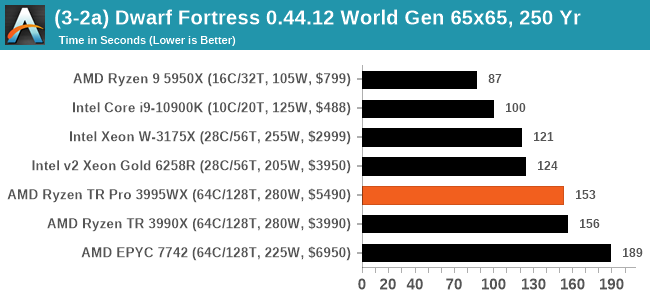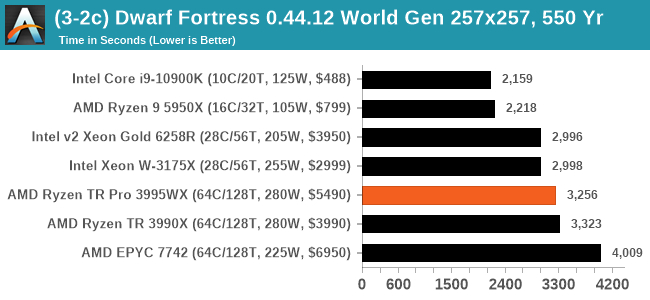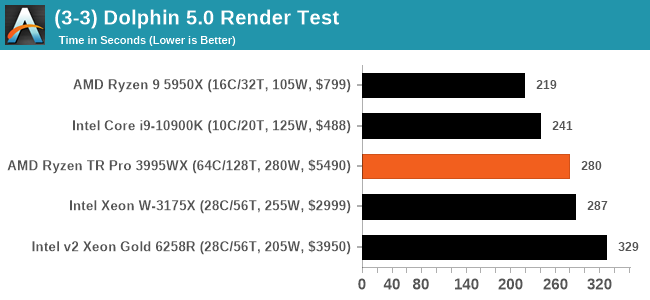64 Cores of Rendering Madness: The AMD Threadripper Pro 3995WX Review
by Dr. Ian Cutress on February 9, 2021 9:00 AM EST- Posted in
- CPUs
- AMD
- Lenovo
- ThinkStation
- Threadripper Pro
- WRX80
- 3995WX
CPU Tests: Simulation
Simulation and Science have a lot of overlap in the benchmarking world, however for this distinction we’re separating into two segments mostly based on the utility of the resulting data. The benchmarks that fall under Science have a distinct use for the data they output – in our Simulation section, these act more like synthetics but at some level are still trying to simulate a given environment.
DigiCortex v1.35: link
DigiCortex is a pet project for the visualization of neuron and synapse activity in the brain. The software comes with a variety of benchmark modes, and we take the small benchmark which runs a 32k neuron/1.8B synapse simulation, similar to a small slug.
The results on the output are given as a fraction of whether the system can simulate in real-time, so anything above a value of one is suitable for real-time work. The benchmark offers a 'no firing synapse' mode, which in essence detects DRAM and bus speed, however we take the firing mode which adds CPU work with every firing.
The software originally shipped with a benchmark that recorded the first few cycles and output a result. So while fast multi-threaded processors this made the benchmark last less than a few seconds, slow dual-core processors could be running for almost an hour. There is also the issue of DigiCortex starting with a base neuron/synapse map in ‘off mode’, giving a high result in the first few cycles as none of the nodes are currently active. We found that the performance settles down into a steady state after a while (when the model is actively in use), so we asked the author to allow for a ‘warm-up’ phase and for the benchmark to be the average over a second sample time.
For our test, we give the benchmark 20000 cycles to warm up and then take the data over the next 10000 cycles seconds for the test – on a modern processor this takes 30 seconds and 150 seconds respectively. This is then repeated a minimum of 10 times, with the first three results rejected. Results are shown as a multiple of real-time calculation.

This test prefers monolithic silicon with proportionally lots of memory bandwidth, which means that we get somewhat of an equalling of results here. The top result in our benchmark database is actually single chiplet Ryzen.
Dwarf Fortress 0.44.12: Link
Another long standing request for our benchmark suite has been Dwarf Fortress, a popular management/roguelike indie video game, first launched in 2006 and still being regularly updated today, aiming for a Steam launch sometime in the future.
Emulating the ASCII interfaces of old, this title is a rather complex beast, which can generate environments subject to millennia of rule, famous faces, peasants, and key historical figures and events. The further you get into the game, depending on the size of the world, the slower it becomes as it has to simulate more famous people, more world events, and the natural way that humanoid creatures take over an environment. Like some kind of virus.
For our test we’re using DFMark. DFMark is a benchmark built by vorsgren on the Bay12Forums that gives two different modes built on DFHack: world generation and embark. These tests can be configured, but range anywhere from 3 minutes to several hours. After analyzing the test, we ended up going for three different world generation sizes:
- Small, a 65x65 world with 250 years, 10 civilizations and 4 megabeasts
- Medium, a 127x127 world with 550 years, 10 civilizations and 4 megabeasts
- Large, a 257x257 world with 550 years, 40 civilizations and 10 megabeasts
DFMark outputs the time to run any given test, so this is what we use for the output. We loop the small test for as many times possible in 10 minutes, the medium test for as many times in 30 minutes, and the large test for as many times in an hour.



Dwarf Fortress is mainly single-thread limiting, hence the 64-core models at the back end of the queue. The TR parts are still a good bit faster than the EPYC.
Dolphin v5.0 Emulation: Link
Many emulators are often bound by single thread CPU performance, and general reports tended to suggest that Haswell provided a significant boost to emulator performance. This benchmark runs a Wii program that ray traces a complex 3D scene inside the Dolphin Wii emulator. Performance on this benchmark is a good proxy of the speed of Dolphin CPU emulation, which is an intensive single core task using most aspects of a CPU. Results are given in seconds, where the Wii itself scores 1051 seconds.

Similarly here, single thread performance matters.












118 Comments
View All Comments
Holliday75 - Friday, February 12, 2021 - link
Oxford Guy: I just want to argue.Spunjji - Thursday, February 11, 2021 - link
They're a professional, they don't care about the name - that was the rebuttal, and it directly addressed your "claim". It doesn't need to be more than their opinion, because your "claim" was just your own turgid opinion.Pseudo-rationalists are a plague.
Oxford Guy - Thursday, February 11, 2021 - link
Another comment that fails to rebut the original claim.grant3 - Friday, February 12, 2021 - link
An industry professional, in the target market for this product, tells you "The name is stellar."Yes, that both addresses + contradicts your claim that you know what inspires "professional confidence" better than the actual professionals.
Spunjji - Thursday, February 11, 2021 - link
p r o f e s s i o n a lSome professionals are gamers. Some have a sense of humour. Some even make games!
But sure, it's not "Xeon", which is "professional" by virtue of being duller than a water flavoured lollipop.
Oxford Guy - Thursday, February 11, 2021 - link
The obsession continues...Qasar - Thursday, February 11, 2021 - link
and its your obsession. nothing wrong with the name threadripper. you want to complain about product names, go look at some names for video cards, or even some motherboards.hmm maybe you dont like the name cause intel didnt make it ?
schujj07 - Thursday, February 11, 2021 - link
Xeon is an even number name than Threadripper of Epyc. The name is too close to Xenon the Nobel gas. If you just heard the name you would think the Intel CPU doesn't play well with anything besides itself.schujj07 - Thursday, February 11, 2021 - link
*dumber not number...stupid autocorrectGeoffreyA - Friday, February 12, 2021 - link
For my part, I think Threadripper is a pretty nice name and have always liked it (it gives the impression of tearing through work with mighty, relentless threading). But I also agree with Oxford Guy's sentiment that names in computing are often made in poor taste (Bulldozer, Netburst, and Core 2 Duo are "choice" specimens). A subjective thing, to be sure, but that's how I feel.